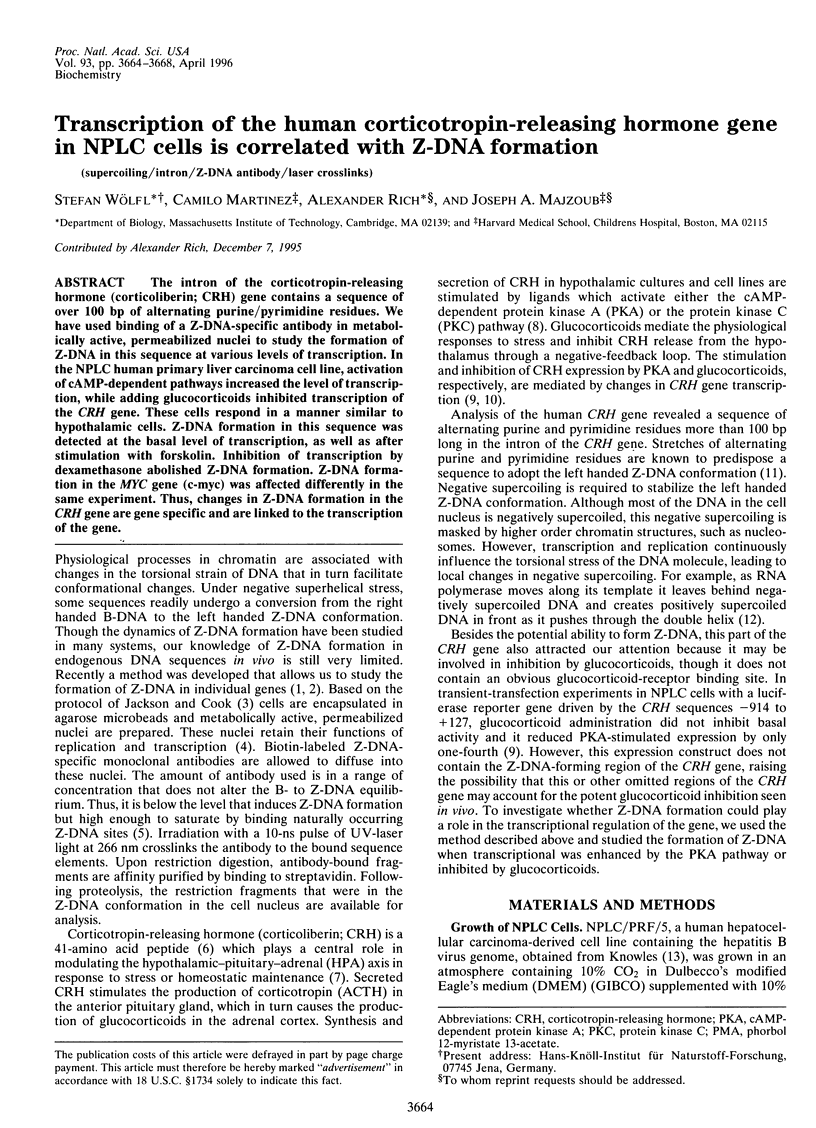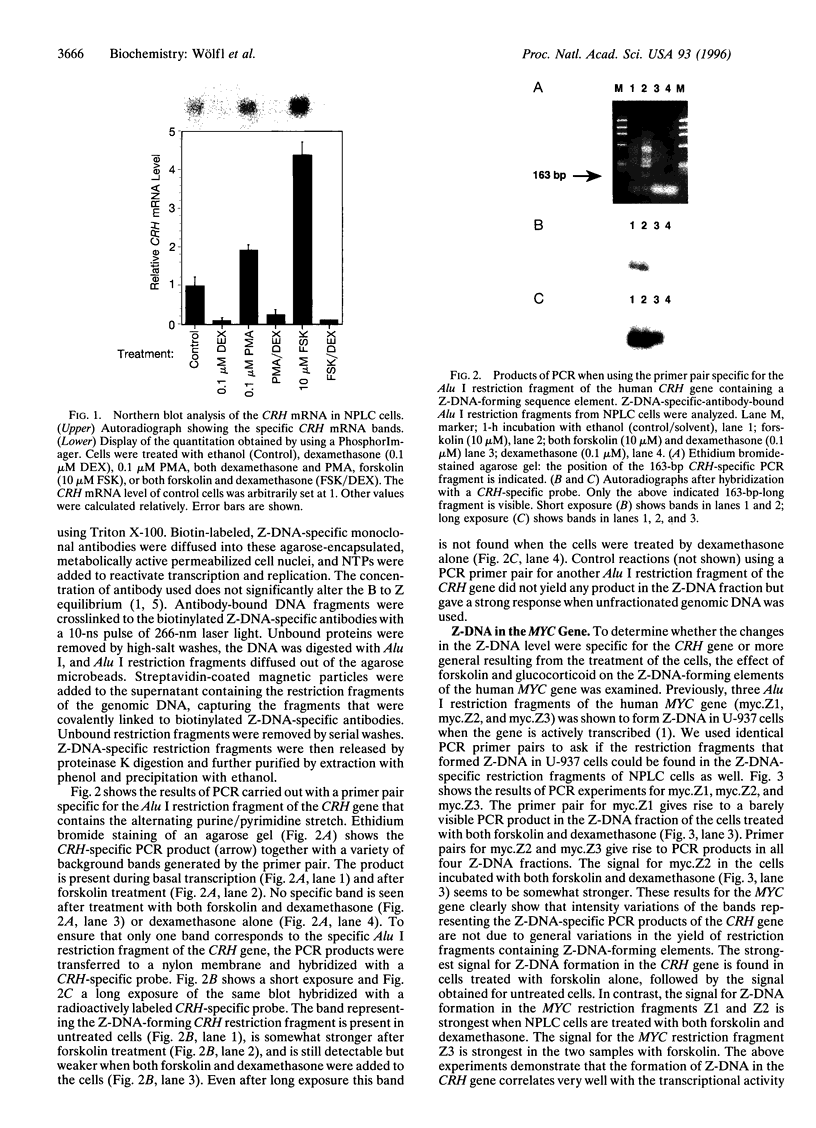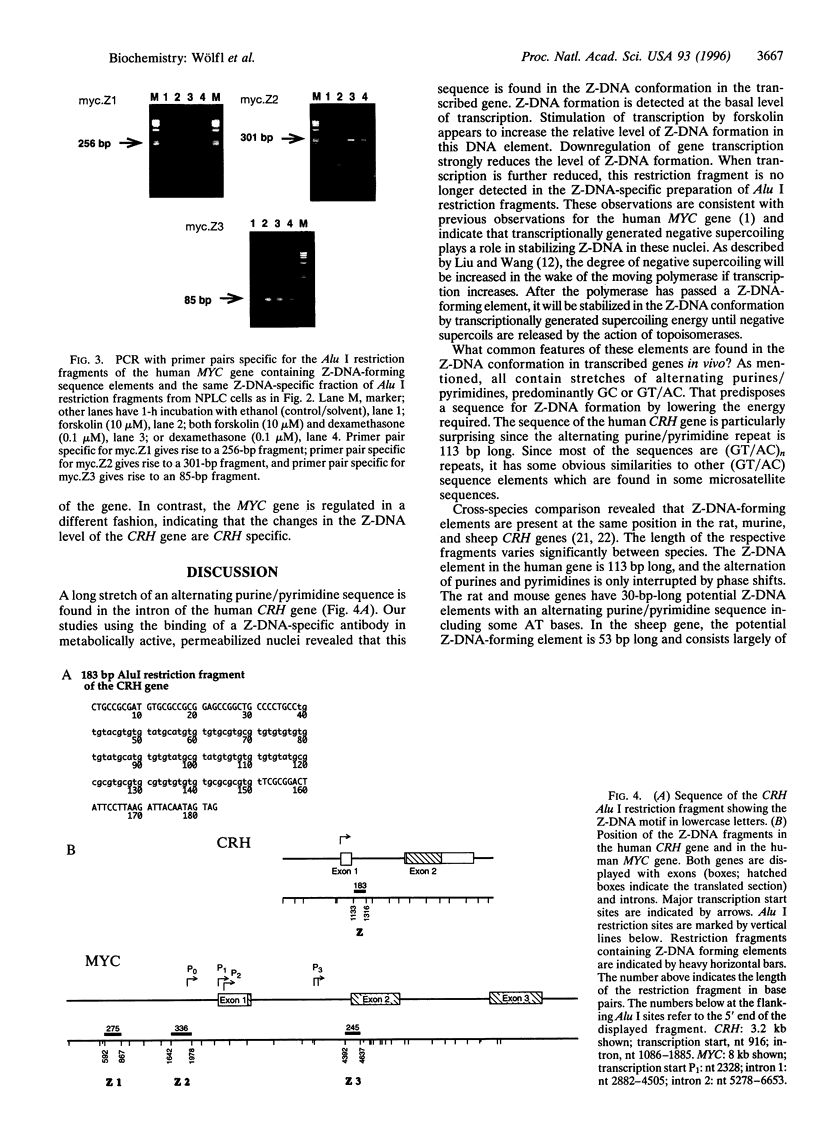Abstract
The intron of the corticotropin-releasing hormone (corticoliberin; CRH) gene contains a sequence of over 100 bp of alternating purine/pyrimidine residues. We have used binding of a Z-DNA-specific antibody in metabolically active, permeabilized nuclei to study the formation of Z-DNA in this sequence at various levels of transcription. In the NPLC human primary liver carcinoma cell line, activation of cAMP-dependent pathways increased the level of transcription, while adding glucocorticoids inhibited transcription of the CRH gene. These cells respond in a manner similar to hypothalamic cells. Z-DNA formation in this sequence was detected at the basal level of transcription, as well as after stimulation with forskolin. Inhibition of transcription by dexamethasone abolished Z-DNA formation. Z-DNA formation in the WC gene (c-myc) was affected differently in the same experiment. Thus, changes in Z-DNA formation in the CRH gene are gene specific and are linked to the transcription of the gene.
Full text
PDF




Images in this article
Selected References
These references are in PubMed. This may not be the complete list of references from this article.
- Adler G. K., Smas C. M., Majzoub J. A. Expression and dexamethasone regulation of the human corticotropin-releasing hormone gene in a mouse anterior pituitary cell line. J Biol Chem. 1988 Apr 25;263(12):5846–5852. [PubMed] [Google Scholar]
- Archer T. K., Zaniewski E., Moyer M. L., Nordeen S. K. The differential capacity of glucocorticoids and progestins to alter chromatin structure and induce gene expression in human breast cancer cells. Mol Endocrinol. 1994 Sep;8(9):1154–1162. doi: 10.1210/mend.8.9.7838148. [DOI] [PubMed] [Google Scholar]
- Arndt-Jovin D. J., Udvardy A., Garner M. M., Ritter S., Jovin T. M. Z-DNA binding and inhibition by GTP of Drosophila topoisomerase II. Biochemistry. 1993 May 11;32(18):4862–4872. doi: 10.1021/bi00069a023. [DOI] [PubMed] [Google Scholar]
- Carlin C. R., Simon D., Mattison J., Knowles B. B. Expression and biosynthetic variation of the epidermal growth factor receptor in human hepatocellular carcinoma-derived cell lines. Mol Cell Biol. 1988 Jan;8(1):25–34. doi: 10.1128/mcb.8.1.25. [DOI] [PMC free article] [PubMed] [Google Scholar]
- Cippitelli M., Sica A., Viggiano V., Ye J., Ghosh P., Birrer M. J., Young H. A. Negative transcriptional regulation of the interferon-gamma promoter by glucocorticoids and dominant negative mutants of c-Jun. J Biol Chem. 1995 May 26;270(21):12548–12556. doi: 10.1074/jbc.270.21.12548. [DOI] [PubMed] [Google Scholar]
- Dröge P., Nordheim A. Transcription-induced conformational change in a topologically closed DNA domain. Nucleic Acids Res. 1991 Jun 11;19(11):2941–2946. doi: 10.1093/nar/19.11.2941. [DOI] [PMC free article] [PubMed] [Google Scholar]
- Emanuel R. L., Girard D. M., Thull D. L., Majzoub J. A. Second messengers involved in the regulation of corticotropin-releasing hormone mRNA and peptide in cultured rat fetal hypothalamic primary cultures. Endocrinology. 1990 Jun;126(6):3016–3021. doi: 10.1210/endo-126-6-3016. [DOI] [PubMed] [Google Scholar]
- Helmberg A., Auphan N., Caelles C., Karin M. Glucocorticoid-induced apoptosis of human leukemic cells is caused by the repressive function of the glucocorticoid receptor. EMBO J. 1995 Feb 1;14(3):452–460. doi: 10.1002/j.1460-2075.1995.tb07021.x. [DOI] [PMC free article] [PubMed] [Google Scholar]
- Herbert A., Lowenhaupt K., Spitzner J., Rich A. Chicken double-stranded RNA adenosine deaminase has apparent specificity for Z-DNA. Proc Natl Acad Sci U S A. 1995 Aug 1;92(16):7550–7554. doi: 10.1073/pnas.92.16.7550. [DOI] [PMC free article] [PubMed] [Google Scholar]
- Jackson D. A., Cook P. R. A general method for preparing chromatin containing intact DNA. EMBO J. 1985 Apr;4(4):913–918. doi: 10.1002/j.1460-2075.1985.tb03718.x. [DOI] [PMC free article] [PubMed] [Google Scholar]
- Jackson D. A., Cook P. R. Different populations of DNA polymerase alpha in HeLa cells. J Mol Biol. 1986 Nov 5;192(1):77–86. doi: 10.1016/0022-2836(86)90465-1. [DOI] [PubMed] [Google Scholar]
- Lafer E. M., Möller A., Nordheim A., Stollar B. D., Rich A. Antibodies specific for left-handed Z-DNA. Proc Natl Acad Sci U S A. 1981 Jun;78(6):3546–3550. doi: 10.1073/pnas.78.6.3546. [DOI] [PMC free article] [PubMed] [Google Scholar]
- Liu L. F., Wang J. C. Supercoiling of the DNA template during transcription. Proc Natl Acad Sci U S A. 1987 Oct;84(20):7024–7027. doi: 10.1073/pnas.84.20.7024. [DOI] [PMC free article] [PubMed] [Google Scholar]
- Majzoub J. A., Emanuel R., Adler G., Martinez C., Robinson B., Wittert G. Second messenger regulation of mRNA for corticotropin-releasing factor. Ciba Found Symp. 1993;172:30–58. doi: 10.1002/9780470514368.ch3. [DOI] [PubMed] [Google Scholar]
- Peck L. J., Wang J. C. Transcriptional block caused by a negative supercoiling induced structural change in an alternating CG sequence. Cell. 1985 Jan;40(1):129–137. doi: 10.1016/0092-8674(85)90316-2. [DOI] [PubMed] [Google Scholar]
- Pennie W. D., Hager G. L., Smith C. L. Nucleoprotein structure influences the response of the mouse mammary tumor virus promoter to activation of the cyclic AMP signalling pathway. Mol Cell Biol. 1995 Apr;15(4):2125–2134. doi: 10.1128/mcb.15.4.2125. [DOI] [PMC free article] [PubMed] [Google Scholar]
- Rich A., Nordheim A., Wang A. H. The chemistry and biology of left-handed Z-DNA. Annu Rev Biochem. 1984;53:791–846. doi: 10.1146/annurev.bi.53.070184.004043. [DOI] [PubMed] [Google Scholar]
- Roche P. J., Crawford R. J., Fernley R. T., Tregear G. W., Coghlan J. P. Nucleotide sequence of the gene coding for ovine corticotropin-releasing factor and regulation of its mRNA levels by glucocorticoids. Gene. 1988 Nov 30;71(2):421–431. doi: 10.1016/0378-1119(88)90059-5. [DOI] [PubMed] [Google Scholar]
- Rosen L. B., Majzoub J. A., Adler G. K. Effects of glucocorticoid on corticotropin-releasing hormone gene regulation by second messenger pathways in NPLC and AtT-20 cells. Endocrinology. 1992 Apr;130(4):2237–2244. doi: 10.1210/endo.130.4.1547737. [DOI] [PubMed] [Google Scholar]
- Scheinman R. I., Gualberto A., Jewell C. M., Cidlowski J. A., Baldwin A. S., Jr Characterization of mechanisms involved in transrepression of NF-kappa B by activated glucocorticoid receptors. Mol Cell Biol. 1995 Feb;15(2):943–953. doi: 10.1128/mcb.15.2.943. [DOI] [PMC free article] [PubMed] [Google Scholar]
- Seasholtz A. F., Thompson R. C., Douglass J. O. Identification of a cyclic adenosine monophosphate-responsive element in the rat corticotropin-releasing hormone gene. Mol Endocrinol. 1988 Dec;2(12):1311–1319. doi: 10.1210/mend-2-12-1311. [DOI] [PubMed] [Google Scholar]
- Spengler D., Rupprecht R., Van L. P., Holsboer F. Identification and characterization of a 3',5'-cyclic adenosine monophosphate-responsive element in the human corticotropin-releasing hormone gene promoter. Mol Endocrinol. 1992 Nov;6(11):1931–1941. doi: 10.1210/mend.6.11.1480179. [DOI] [PubMed] [Google Scholar]
- Swanson L. W., Sawchenko P. E., Lind R. W., Rho J. H. The CRH motoneuron: differential peptide regulation in neurons with possible synaptic, paracrine, and endocrine outputs. Ann N Y Acad Sci. 1987;512:12–23. doi: 10.1111/j.1749-6632.1987.tb24948.x. [DOI] [PubMed] [Google Scholar]
- Thompson R. C., Seasholtz A. F., Herbert E. Rat corticotropin-releasing hormone gene: sequence and tissue-specific expression. Mol Endocrinol. 1987 May;1(5):363–370. doi: 10.1210/mend-1-5-363. [DOI] [PubMed] [Google Scholar]
- Vale W., Spiess J., Rivier C., Rivier J. Characterization of a 41-residue ovine hypothalamic peptide that stimulates secretion of corticotropin and beta-endorphin. Science. 1981 Sep 18;213(4514):1394–1397. doi: 10.1126/science.6267699. [DOI] [PubMed] [Google Scholar]
- Van L. P., Spengler D. H., Holsboer F. Glucocorticoid repression of 3',5'-cyclic-adenosine monophosphate-dependent human corticotropin-releasing-hormone gene promoter activity in a transfected mouse anterior pituitary cell line. Endocrinology. 1990 Sep;127(3):1412–1418. doi: 10.1210/endo-127-3-1412. [DOI] [PubMed] [Google Scholar]
- Wittig B., Dorbic T., Rich A. The level of Z-DNA in metabolically active, permeabilized mammalian cell nuclei is regulated by torsional strain. J Cell Biol. 1989 Mar;108(3):755–764. doi: 10.1083/jcb.108.3.755. [DOI] [PMC free article] [PubMed] [Google Scholar]
- Wittig B., Wölfl S., Dorbic T., Vahrson W., Rich A. Transcription of human c-myc in permeabilized nuclei is associated with formation of Z-DNA in three discrete regions of the gene. EMBO J. 1992 Dec;11(12):4653–4663. doi: 10.1002/j.1460-2075.1992.tb05567.x. [DOI] [PMC free article] [PubMed] [Google Scholar]





